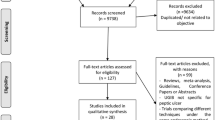Abstract
Background: There are several methods of achieving endoscopic hemostasis for nonvariceal hemorrhage, including use of a heater probe, bipolar electrocoagulation, use of a Gold probe, and injection therapy with epinephrine or ethyl alcohol. However, due to clinical variations, clinical studies comparing thermal with injection therapy have yielded conflicting results. Therefore, we used a canine model of acute bleeding from gastric serosal vessels to examine the efficacy of the heater probe and the Gold probe in achieving hemostasis and to compare the injurious effects of these methods with injection therapy.
Methods: Seven mongrel dogs were used in the study. Four were assigned to acute experiments in which transected blood vessels were allowed to bleed profusely. Two dogs of this group were treated with either a large or small Gold probe, while the other two were treated with either a large or small heater probe. In the other three dogs, we tested the chronic effects of the heater probe, the Gold probe, and injection therapy with dilute epinephrine.
Results: Complete hemostasis was achieved for all four dogs in the acute experiments. Dogs treated with either a large or small heater probe had coagulation necrosis that extended to the serosa and muscularis but not to the mucosa. The large Gold probe had similar results, but the small Gold probe caused tissue damage to the serosa, muscularis, submucosa, and mucosa at several of the application sites. Both probes caused scarring of the gastric wall. In the chronic experiments, we found that the Gold probe caused larger mucosal ulcers than the heater probe. All ulcers healed in 3 weeks. The epinephrine injection caused localized swelling and discoloration, but after 1 week the tissue returned to normal.
Conclusions: Both the heater probe and the Gold probe are effective in achieving hemostasis in a canine model of nonvariceal hemorrhage, and both methods are superior to injection therapy. For active bleeding ulcers, we currently recommend a combination therapy, using first injection therapy and then a heater or Gold probe. However, clinicians should be aware of the potential for tissue damage.
Similar content being viewed by others
Author information
Authors and Affiliations
Additional information
Received: 31 July 1998/Accepted: 22 March 1999
Rights and permissions
About this article
Cite this article
Sugawa, C., Takekuma, Y., Lucas, C. et al. Experimental studies of thermal therapy for severe nonvariceal bleeding in dogs. Surg Endosc 13, 1203–1207 (1999). https://doi.org/10.1007/PL00009621
Issue Date:
DOI: https://doi.org/10.1007/PL00009621




